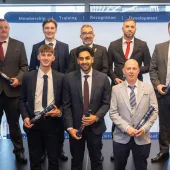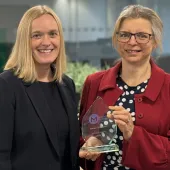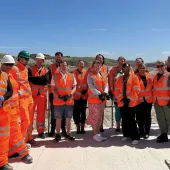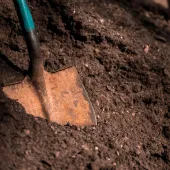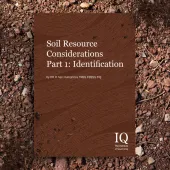Annual Conference 2006 Review

Dull outside but brilliant indoors
The Annual Conference 2006 was hosted by the Devon & Cornwall branch at the Palace Hotel, Torquay, on 5–6 October. The venue is the former palace of the Bishop of Exeter set in beautiful gardens and woodland only minutes from Anstey’s Cove.
The Devon & Cornwall branch committee took the lead in preparing the conference with assistance from the Waste Resources Action Programme (WRAP) and Quarry Products Association (QPA). Together, they should be congratulated for organizing a most stimulating programme for the symposium, the theme of which was ‘Optimization of mineral resources for a sustainable future’. Speakers had been asked to address this theme by discussing the use of mineral resources in terms of government policy and guidance, drivers towards more sustainable use, challenges facing the quarrying industry, and recent successes and experience. Before the event the concern had been expressed that delegates might not travel to a conference in the South West but, by any measure, the symposium proved to be a great success with 170 delegates, well above the planned attendance. Unusually, the weather on the Friday was wet but this ensured that nobody missed the series of excellent presentations that comprised the symposium.
The proceedings began with a welcome by Tom Hilton, chairman of the Devon & Cornwall branch, who introduced the recently elected president, Cedric Hollinsworth. Cedric then proceeded to award the prizes beginning with the prizes for the Institute’s Professional Examination.
First among the prize-winners was Graham Turk who won the most prestigious Clugston Award for obtaining the highest number of marks in the IQ Professional Examination. He also won the Ransome Rapier Award for Engineering and came runner-up in the Preston Award. James Buchanan won the Coles Award for Health & Safety and also came runner-up for the Tilcon Award for Business Management. Robert Cross was runner-up for the Ransome Rapier Award. Ian Gault won the Rexnord Award for Blasting and Andrew Smith was runner-up. Cathal Lavin won the Goodwin Barsby Award for Construction Materials Testing and James Macey won the Tilcon Award and came runner-up for the Goodwin Barsby Award. Regrettably, Pat Robinson, winner of no less than three awards, runner-up in the Clugston and Coles Awards and winner of the Preston Award for Quarry Operations, could not attend.
There then followed the presentations of awards for members who had presented papers to meetings of The Institute. The Marston Award was not presented this year because no nomination of a written paper had been received by The Institute. The Ruston Bucyrus Award went to Alan Connolly of Hulands Quarry for his very personal account of implementing the Working Time Directive, which he delivered to the delegates at the 2005 annual conference.
Finally, the President invited Kevin Sargant, chairman of the West of England branch, to accept the President’s Branch Trophy. This award recognizes the extraordinary achievement of the West of England branch, which has won the trophy five times and completed a hat-trick in the years 2004, 2005 and 2006!
The symposium was arranged simply as two consecutive sessions chaired by the newly elected president, Cedric Hollinsworth, and Simon van der Byl, director general of the QPA. As an innovation, the stage set included an extra screen showing the live image of the speaker and the entire proceedings were recorded on video tape to allow transcripts to be produced if required.
‘Digging up the best bits to concrete over the rest’ was a description of the quarrying industry overheard by Prof. Chris Baines who gave the keynote address to the delegates and introduced the theme of the conference. Chris, a renowned broadcaster, TV presenter, writer and environmentalist, made a highly illustrated presentation on the opportunities for the quarrying industry to reverse this image through contributing to sustainability and publicizing its achievements. For example, he had worked with ARC and the Game Conservancy Council at Great Longford (Milton Keynes) on pioneering research to restore the quarries to habitat for waterfowl long before the RSPB became involved. He continued by saying that an often-stated criticism of quarrying is that it has a long-term impact on the local community, but that this also offers a long-term involvement and contribution to that same community. He recommended a number of actions by the quarrying industry to improve its sustainability.
First, it could exploit the enormous appetite of the general public for structured, conducted contact with nature using restored quarries. In his opinion, this was not sufficiently well publicized and he cited the Great Fens project to recreate an enormous area of wetlands.
Second, the industry should participate in regional planning of land, water and catchment areas to control the rising risk of flooding through promotion of materials such as porous surfacing and drainage schemes. Quarries could also be promoted as established sites suitable for the recycling and distribution of recycled materials. In general, the quarrying and construction industry should become more concerned with promoting the appropriate use of its products than the potential impacts of production.
The keynote address was followed by John Barritt, aggregates technical advisor, Waste Resources Action Programme (WRAP), who explained the objectives of WRAP and its recent reorganization. The principal objective of WRAP is to promote the uses of waste through the development of markets. Until recently wastes were considered according to type or waste stream, such as glass or paper, but now waste generation is being considered according to sector, such as retail or construction. Aggregates are by far the greatest construction material as measured by tonnage or volume. The five themes of WRAP are:
- increase quality
- raise awareness
- overcome barriers to use
- research uses
- disseminate information.
With respect to aggregates, there is now a huge and very user-friendly web site called AggRegain.
At the present time, John reported that approximately 70 million tonnes a year of construction material is recycled as aggregate, equivalent to about 25% of demand. Research is continuing on the use of recycled materials in hydraulically bound materials (HBM) and minimization of CO2 emission by recycling. He finished by presenting the findings of a model that predicted future use of recycled materials, which estimated that a stable position would be reached at about 30%.
An interesting example of the more efficient use of a mineral resource, ball clay, was then described by Ray Bovey, head of engineering, WBB Minerals. Ray began by explaining the formation of ball clays by the weathering of feldspars in granites to produce very finely crystalline, plastic kaolinite. The clays were laid down by water in lakes as seams of varying quality interbedded with sands, gavels and lignite. Typically, only 15% could be recovered as ball clay with 15% overburden and 60% interburden. Because it is becoming almost impossible to obtain permission for tips, the company investigated the processing of waste to recover more clay and construction sand, and a process plant was constructed with a capital grant from WRAP. Soil substitutes are also being manufactured using sands and lignite waste and the target is to increase the yield of saleable products to 53%.
A very interesting and informative presentation was then made by David Gibson, QUENSH advisor, Alfred McAlpine Civil Engineering, who explained the factors influencing a construction company to use recycled aggregates. The principal driver is cost and the imposition of the aggregates levy favours the use of recycled and secondary materials. The specification of material tends to favour primary aggregates but the client may demand the use of a proportion of recycled material. Considerations of quality and availability may preclude recycled and secondary materials but the creation of an award scheme (CEEQUAL) by the Institution of Civil Engineers provides a powerful incentive for use of recycled materials where this is possible. The Quality, Environmental, Safety and Health (QUENSH) policy of the company will also favour recycled materials and may win contracts. David admitted that consistency of quality was now good and did not deter the use of recycled materials but waste legislation most certainly did. The Environment Agency had created some exemptions for recycled and secondary materials so that they would not be classified as ‘waste’ but then introduced a protracted application procedure and fee. He concluded by illustrating some examples of the use of large quantities of recycled and secondary aggregates by Alfred McAlpine in recent improvements to the A30 and A1 roads.
Natalie Bennett, team leader, Geology, Landscape and Soils, informed delegates that Natural England (NE) had been officially formed only a few days ago through the amalgamation of English Nature, the Countryside Agency and Rural Development Service. Compared to English Nature, the new organization had a wider remit to help people have access to, enjoy and understand the natural environment and to consider economics and sustainable development. Thus, NE would be concerned with much more than nature conservation. In her opinion, the quarrying industry could contribute to all of the aims of NE. In the immediate future, Natalie did not foresee any change in the behaviour of NE as a statutory consultee or the Minerals & Nature Conservation Forum. However, it might be expected that the response of NE will be broader and that more staff will be involved.
After lunch, the usual ‘graveyard’ session was entirely transformed by an inspirational, informative, entertaining and totally unscripted talk by Tim Smit, chief executive of the Eden Project. Tim trained as an archaeologist and had a successful career as a record producer when his friend inherited a property which they set about restoring and has since become known as the ‘Lost Gardens of Heligan’. Armed with that experience and a lot of enthusiasm, Tim first purchased an exhausted china clay pit and then raised funds to create the ‘Eden Project’. He explained that the inspiration for the Eden Project had come from the view of the sun setting over Goonbarrow china clay waste tips! Apparently, the ‘Eighth wonder of the world’ had started with a grant of £20,000 from a local council but later major sponsors and supporters were the architects, Grimshaws, and both McAlpine companies. Tim’s account of the construction of the Eden Project and his philosophy of life were extremely entertaining and informative.
Dr Paul Phillips, technical development director for Aggregate Industries, rose to the challenge of following Tim Smit by describing some of the uses of aggregates derived from waste and the emerging standards for recycled aggregates. He said that standards were needed because tenders increasingly required the use of recycled and secondary materials. Some examples of aggregates derived from waste were: road planings, crushed concrete, slate waste, china clay sand, slags, spent rail ballast, fly ash, rubber crumbs from worn tyres, paper as cellulose fibre, incinerator bottom ash (IBA), and glass. The standards being developed by the committee CEN/TC 154 are based on performance rather than properties to permit wider use.
Emerging issues are the ‘carbon footprint’ of construction projects, life-cycle analysis of products including aggregates, and SuDS (sustainable drainage systems) for the design of hard landscapes, such as car parks.
A second example of the reuse of construction materials was described by Rob Lamont, principal engineer, Parsons Brinckerhoff. Rob explained that his company has a contract for the maintenance of highways in the South West and that a 12km stretch of the A38 had begun to collapse dangerously. The reason was found to be the insufficient depth of construction, so the entire road surface was excavated and recycled off site using the Foamix process developed by Roadstone Recycling. The recycled asphalt was then overlaid with a new binder course and surface course. It was estimated that the recycling saved 70,000 tonnes of aggregates, 55% of CO2 and 250,000 miles of truck haulage. Because no diversion was possible, the project employed sophisticated traffic management to change driver behaviour.
Ruth Chambers, acting chief executive, Council for National Parks, then presented her view of the three most important issues facing the industry: climate change, open space, and ‘letting go’. The first could be tackled by adopting corporate social responsibility (CSR), measuring energy consumption and the carbon footprint, and increasing employee awareness of energy consumption. The second referred to the importance that many people attached to open space for both physical and mental health. This issue could be tackled by being a ‘good neighbour’, minimizing the impact of road traffic, choice of location and use of recycled and secondary aggregates. The final issue was, perhaps, more contentious and referred to dormant permissions, land banks and restoration. Ruth asked the quarrying industry to consider abandoning dormant permissions in the National Parks and taking responsibility for the restoration of ‘orphan’ quarries.
In typical thought-provoking and colourful style, Nigel Jackson, representing the CBI Minerals Group, concluded the proceedings by presenting his recommendations for a way forward. First, he established the importance of the minerals industry within the UK economy as generating £26 billion, to which non-energy minerals contribute £3.5 billion. The per capita consumption of minerals in the UK is 10 tonnes, dominated by aggregates.
He lamented the present situation within the UK with political problems, bio-threats and warnings of climate change. Further restrictions are imposed upon the industry by ‘sustainability-itis’ and ‘stakeholder-itis’. Politically, the Government states that it recognizes the need for minerals, which is forecast to remain static or even increase, but places obstacles to their exploitation by taxing planning permissions. Globally, minerals extraction is obstructed by activities of NGOs, ‘summitry’, the subjugation of science by propaganda, involvement of celebrities in political activity and ‘wonking’ (the implementation of directives on everything)!
He feared that MPS1 would be a disaster for the minerals industry creating chaos through more change, three national systems in one small island, more stakeholders and more delay. The Mineral Planning Authorities appeared to be under-resourced and losing skilled staff, while statutory authorities seemed to be determined to gather power and influence over local concerns. Operationally, the industry was struggling against tighter controls on noise and dust, greater protection of water resources and extraordinary concern for archaeology.
In his opinion, the industry must find a way to improve its image and communicate its achievements; a Whitehall champion must be found. At the same time, it must be competent, tidy, carbon aware, open, involved with the local community, and create minimal impact. As an initial step, the UK Minerals Forum will be launched this month (November) with the principal participants being the CBI, DEFRA, DCLG and DTI.
The success of the symposium was matched by the social events with both dinners exceeding the planned numbers. On the Thursday evening, the branch had arranged a novel treat for delegates and guests at Powderham Castle, the ancestral home of the Earl and Countess of Devon and the most popular tourist destination in Devon. After a meal, diners were invited to try their luck on gaming tables at blackjack, roulette and poker. The largest pot of ‘toy money’ was accumulated by Andrew Smith. Those who attended the dinner and dance enjoyed an excellent menu and the music performed by a band of Royal Marines from Plymouth called ‘Sound Advice’.
The outing for partners of the delegates comprised a visit to the Eden Project near St Austell, which is itself a restoration to amenity of a former china clay pit. The Institute is grateful to Metso Minerals for sponsoring the dinner and dance and to QMJ Publishing for sponsorship of the conference. The ladies’ gifts of local glass at the dinner and dance were purchased with money raised by the former Associates Section.


